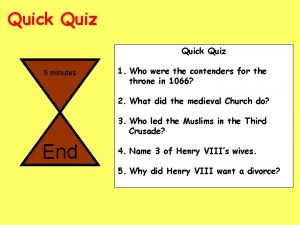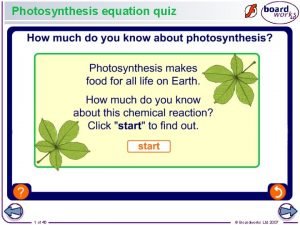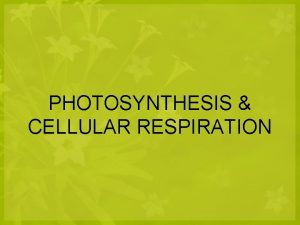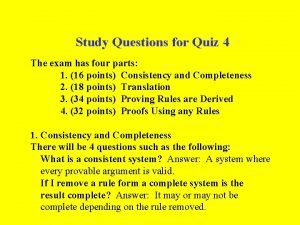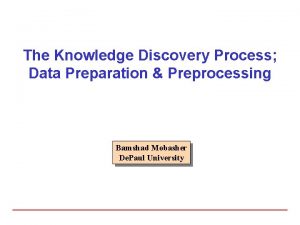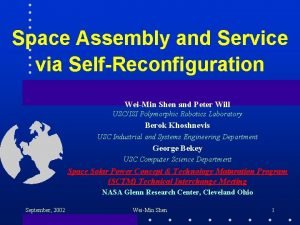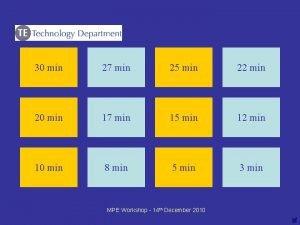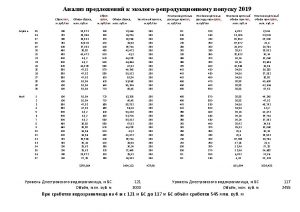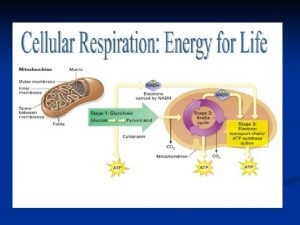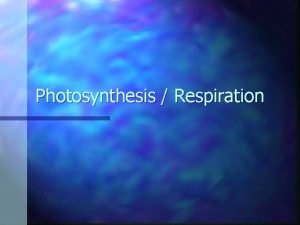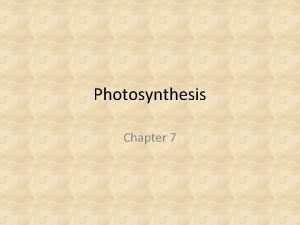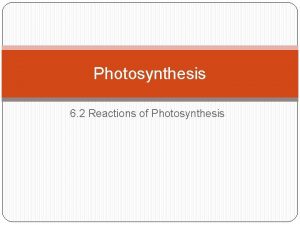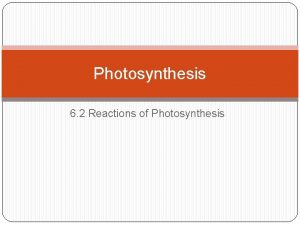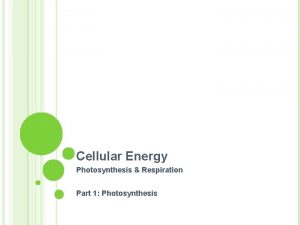AGENDA Warmup study 10 min QUIZ on Photosynthesis




































- Slides: 36

AGENDA Warm-up = study 10 min. *QUIZ on Photosynthesis*

Agenda • Photosynthesis Quiz • Notes on Cellular Respiration • Worksheet

Objective • We will learn the process of cellular respiration: how mitochondria use glucose to make ATP.

Vocabulary • Acetyl-Co. A • Alcoholic Fermentation • Anaerobic • Aerobic • Calorie • Cellular Respiration • Cristae • Ethyl Alcohol • • • FAD+ FADH Fermentation Glycolysis Krebs Cycle Citric Acid Metabolism Mitochondria Pyruvic Acid

Chemical Energy • Why do we eat? We need to consume food so we can break it down into usable energy. • The amount of energy we can get from food is calculated by the amount of calories it contains. • A calorie = amount of energy needed to raise the temperature of 1 g of H 2 O by 1 degree Celsius. • You don’t literally “burn” through the glucose in food, your cells slowly release the energy it contains over time. This is measured by your Metabolism.

Mitochondria • The organelle for cellular respiration powerhouse of the cell. Structure: made of 2 membranes: • inner matrix, and outer cristae

What type of organisms perform respiration? • All plants and animals perform cell respiration because they all have the mitochondria organelle in their cells.

Cell Respiration Formula • Cellular Respiration is the process of breaking down the glucose in your food in the presence of oxygen. • Formula: • C 6 H 12 O 6 + 6 O 2 = 6 H 2 O + energy (heat and ATP) + 6 CO 2

Overview • Glucose + oxygen carbon dioxide + water + energy • Mitochondria perform respiration; we get energy (up to 38 ATP), then we breathe out carbon dioxide and water.

Steps to Respiration • 1. ) Glycolysis • 2. ) Krebs Cycle (Citric Acid Cycle) • 3. ) Electron Transport Chain (ETC)

Step 1: Glycolysis • Location: the cytoplasm outside the mitochondria in a cell. • Glycolysis is the process of breaking 1 molecule of glucose into 2 molecules of pyruvic acid (a 3 carbon molecule).

• Glycolysis is a fast process, and is the only step that does not require oxygen (anaerobic). It also creates 2 ATP’s.

Step 2: Krebs Cycle (Citric Acid Cycle) • The pyruvic acid made during glycolysis moves into the mitochondria matrix, as it does it changes names into Acetyl -Co. A (also known as Citric Acid) it has only 2 carbons. • This is done by releasing one CO 2 molecule from the pyruvate, and by creating an NADH (energy molecule like NADPH).

• Acetyl-Co. A continues to move through the Krebs Cycle, releasing its last 2 carbons as CO 2 we breathe out, and making NADH, FADH 2 and 2 ATP’s.

• So far we have learned steps 1 & 2, and made only 2 ATP… Step 3

Step 3: Electron Transport Chain • The ETC uses the high-energy molecules (NADH and FADH 2) from the Kreb’s Cycle to convert ADP into ATP. This is achieved by using the ATP Synthase protein channel in the Cristae membrane of the mitochondria. • For prokaryotes the ETC is in the cell membrane.


Cell Respiration Steps

• What organelle performs Cellular Respiration? Think. Pair. Share! • What are the names of the 3 steps to cell respiration? • What is another name for the Krebs Cycle, and why? • How many total ATP are made through cell respiration?

Fermentation • When oxygen is not present for respiration, step 1: glycolysis is followed by fermentation, an anaerobic process, in the cytoplasm.

2 Types of Fermentation: Alcoholic Fermentation • Done by yeast in bread making: • Produces Ethyl Alcohol and CO 2 Lactic Acid Fermentation • Occurs when exercising rapidly and cannot supply muscles with enough O 2. • Produces Lactic Acid and CO 2 • Results in muscle soreness



Think-Pair-Share! • What happens if there is NO oxygen present for cellular respiration? • What are the 2 types of anaerobic fermentation? • What location in the cell does fermentation occur?

One man’s trash is another man’s treasure! • The products of photosynthesis are the reactants of respiration. • The products of respiration are the reactants of photosynthesis.


Net Results • Photosynthesis (chloroplast) = Glucose total: 1 • Like “depositing” money into a bank • Respiration (mitochondria) = ATP total: 36 • Like “withdrawing” money from a bank

Worksheet for Cell Respiration • Answer all the questions and complete the diagram using your notes.

Quiz coming up… • LAB next class! Study: Cell Respiration Notes & Diagrams! Q 2 Test 14 th & 15 th

AGENDA • Card-Sort Puzzle • QUIZ on Respiration • LAB on Respiration

Safari Montage Videos • Intro to Cell Respiration • Cellular Respiration • Respiration in Plants

Exercise & Respiration Lab • Purpose: To analyze the effect of exercise on cell respiration. • Hypothesis: How will exercise affect your bodies production of CO 2? • Supplies: Beaker, straw, graduated cylinder, bromethymol blue (BTB). • Procedures: • Part A- (Resting) measure each group member’s: CO 2 production, breathing rate, and heart rate. Do this 3 x, then calculate the average. • Part B- (Exercising) measure each group member’s: CO 2 production, breathing rate, and heart rate after 1 minute of exercise, then after another 2 minutes of exercise. • Analysis: Calculate the resting and exercise averages for all

YOU CO 2 Ea ch yo stud ur gro ent i up n Breathing At th Heart Rate e en calc d of the ulat lab: e A rage LL s! ave


Card-sort Activity • In your group, arrange 9 cards into 3 x 3 square. • Match up vocabulary and definitions! Venn Diagram Activity • Each person will get a paper, use the terms at the top to fill in the sections for Respiration, Photosynthesis, or both! • Use ALL the words, some multiple times!

Warm-up • Fill out the Photosynthesis & Respiration Venn Diagram: Animal Cells Krebs Cycle Acetyl-Co. A Glycolysis Lactic Acid Pyruvic Acid Mitochondria FAD+ FADH CO 2 Produced O 2 Used Heterotrophs Aerobic C 6 H 12 O 6 Used Cytoplasm Calvin Cycle Light-Dependent Stroma Plant Cells Phosphate ATP Glucose Anaerobic ETC Interdependent Thylakoid Chloroplast NADPH NADP+ Photons Photophosphorylation Chlorophyll C 6 H 12 O 6 Produced CO 2 Used H 2 O Used Autotrophs
 Warmup ratio
Warmup ratio Warmup 65
Warmup 65 Gmass warmup
Gmass warmup Status vs class
Status vs class Pyramid warmup
Pyramid warmup Mind rhyming words
Mind rhyming words Multiplying exponents with same base
Multiplying exponents with same base Java warmup
Java warmup Define:warmup
Define:warmup Ethos warmup
Ethos warmup Tinman schwartz
Tinman schwartz Warmup 65
Warmup 65 Warmup end
Warmup end Agenda sistemica y agenda institucional
Agenda sistemica y agenda institucional Queue quiz
Queue quiz Tudor religious rollercoaster
Tudor religious rollercoaster Photosynthesis equation quiz
Photosynthesis equation quiz Bioflix quiz: photosynthesis
Bioflix quiz: photosynthesis Every quiz has been easy. therefore, the quiz will be easy
Every quiz has been easy. therefore, the quiz will be easy Every quiz has been easy. therefore, the test will be easy.
Every quiz has been easy. therefore, the test will be easy. Study quiz
Study quiz Ecological study vs cohort study
Ecological study vs cohort study Retrospective cohort study vs prospective cohort study
Retrospective cohort study vs prospective cohort study What is work study in management
What is work study in management Marty lobdell
Marty lobdell Phytogeographical zones of india
Phytogeographical zones of india Distinguish between motion study and time study
Distinguish between motion study and time study Time and motion study example ppt
Time and motion study example ppt Konstruktor wykrywacza min
Konstruktor wykrywacza min Timeregistering reisetid
Timeregistering reisetid Min max normalization example
Min max normalization example Nilai minimal adalah
Nilai minimal adalah Studievalgsportfolio skabelon
Studievalgsportfolio skabelon Gak syngende din ven i møde
Gak syngende din ven i møde Shen, wei-min
Shen, wei-min Local minimum
Local minimum Richard k min
Richard k min















